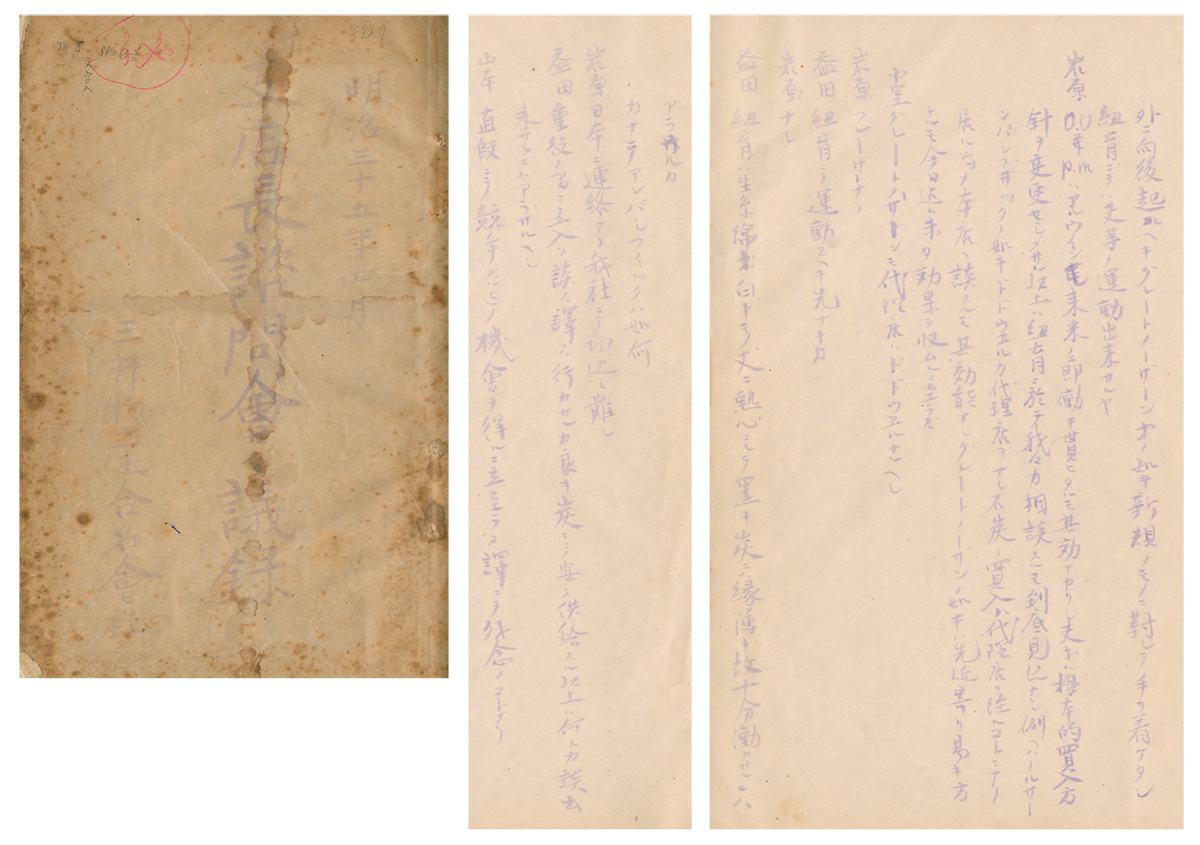32 Global Expansion of Mitsui Bussan

Growing into an Exporter
Sales were growing steadily at Mitsui Bussan, which had reorganized as an unlimited partnership in 1893. Trading volume at Mitsui Bussan comprised 10.43 million yen in exports and 33.54 million yen in imports in 1897, but by 1911 exports had increased to 111.64 million yen (up 10.7 times over 1897), while imports grew to 113.33 million yen (up 3.4 times). The growth in export trading volume was particularly remarkable, coming to compete with the value of imports. Trading volume at Mitsui Bussan in 1911 represented about a quarter of exports for Japan as a whole, with imports representing about one-fifth.
During this period, coal, machinery, cotton, cotton yarn and other products remained the mainstay of the business, but in the period following the Russo-Japanese War, raw silk was one of the fastest-growing products by volume. Mitsui Bussan outpaced foreign trading companies in raw silk exports, primarily to the U.S., and increased its market share.
Branch Network Expansion
The expansion of the business was of a piece with the expansion of the branch network. As of February 1893, there were six domestic branches-Yokohama, Osaka, Kobe, Hakodate, Otaru, and Bakan (present-day Shimonoseki)-and seven smaller branches in Miike, Kuchinotsu, Nagasaki, Shimabara, Misumi, Takasaki, and Wakamatsu. There were four overseas branches, in Shanghai, Hong Kong, London, and Singapore, with smaller branch offices in Tianjin and Bombay (present-day Mumbai). As of January 1893, employees noted on the company’s personnel record numbered about 250 people (apprentices and above).
Looking at the company as of May 1911, in Japan they had added two branches, in Nagoya and Moji, and Miike and Nagasaki had been promoted to full branches, while the Bakan branch and the smaller branch offices in Shimabara, Misumi, and Takasaki were eliminated. Overseas, a new branch had been added in Taipei, while the New York branch was reopened (→Fig. 32b) and the smaller Tianjin and Bombay branches were promoted to full branches. New branch offices were established primarily in Asia, including Tainan, Keijo (present-day Seoul), Andong Prefecture (present-day Dandong), Dalian, Hankou (present-day Wuhan), as well as San Francisco. Employees number 1,166 people.
Organizers of Industrialization
Mitsui Bussan was thus on its way to becoming a general trading company doing business around the world in a diversity of products. The company’s activities ranged widely across trade, finance, marine transport and others. At the same time, there was also a side to the company that went beyond the bounds of a simple trading company; as it gathered the latest information from around the globe and supported the development of industrial companies based on that information, Mitsui Bussan became known as the “organizers of industrialization.” One famous example is its support for the business of Sakichi Toyoda, founder of Toyota Group.
Branch Managers’ Meetings
Mitsui Bussan would convene its branch managers from each region in Tokyo for branch managers’ meetings (known until 1913 as the branch managers’ advisory council). The meetings were attended by executives and personnel in charge from the head office divisions, and personnel from Mitsui Mining and other affiliated companies would sometimes also participate.
The company kept detailed minutes of these branch managers’ meetings, and from these we can learn specifics about the company’s management policies, the status of and issues with its products and branches, problems with organizational management and measures to improve them, among other issues.
For example, the minutes of the 1913 meeting of the Branch Managers’ Advisory Council, held from July 10 to July 31, were compiled in a large volume running to 626 letterpress printed pages. That record includes discussion of 10 advisory proposals, one of which read, “Although the dramatic rise in the value of goods handled is something to be welcomed, considering the relationship to financing and the net profit ratio, there may be a need to adopt a policy of reduction. What are your thoughts on this?” Also recorded are discussions by product-specific subcommittees in coal, machinery, cotton and others.
At the branch managers’ meetings, there would sometimes be heated discussions between those from the head office and the branch managers, or between the branch managers themselves (→Fig. 32a). While the meetings served as a venue for conveying head office policies to the branch managers, they were also a place where the branch managers, all of whom were highly skilled, engaged in free and vigorous discussions and worked out management strategies for Mitsui Bussan (→Fig. 32c).

This is part of a discussion at a 1902 meeting of the Branch Managers’ Advisory Council concerning measures to expand sales channels for coal (cover at left). Masuda Takashi (director) asks Iwahara Kenzo (New York branch manager) if the New York branch can work to encourage foreign shipping companies to purchase coal for fuel for their steamers. Iwahara says that would be difficult, but Masuda presses him, saying, “There is so much focus on producing raw silk and cotton-white goods-that there seems to be little attention given coal-black goods.” As a result, is it not possible that we are failing to achieve the full potential of our work?”
The above historical document was handwritten and then copied using the hectograph (or “gelatine”) method (from the following year’s minutes, they were printed via letterpress). This method was widely used at Mitsui Bussan in the prewar period, but the characters tend to fade with age, and parts of this document have gradually become more difficult to decipher.
Today, minutes from 18 Branch Manager Advisory Council meetings (branch manager meetings) from 1900 to 1931 have been confirmed.

The building where the New York branch of Mitsui Bussan, which reopened in 1896, was located.

This photo was taken in front of the large hall of the Mitsui Kita family during a branch managers’ meeting held in June 1926. At center in front (9th from the right) can be seen Mitsui Takamine (→38), founder and head of Mitsui Gomei Kaisha (Mitsui Partnership Company).
